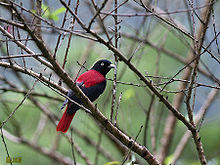| Maroon oriole | |
|---|---|
_-_cropped.jpg) | |
| O. t. traillii (Nepal) | |
| Scientific classification | |
| Kingdom: | Animalia |
| Phylum: | Chordata |
| Class: | Aves |
| Order: | Passeriformes |
| Family: | Oriolidae |
| Genus: | Oriolus |
| Species: | O. traillii |
| Binomial name | |
| Oriolus traillii (Vigors, 1832) | |
| Synonyms | |
| |
The maroon oriole (Oriolus traillii) is a species of bird in the family Oriolidae. It is found in Southeast Asia.
Taxonomy and systematics
The maroon oriole was originally described in the genus Pastor. Along with the black, black-and-crimson and silver orioles, it belongs to a clade of red and black orioles.[2]
Subspecies
Four subspecies are recognized:[3]
- O. t. traillii - (Vigors, 1832): Found from the Himalayas to southern China, northern Indochina and northern Thailand
- O. t. robinsoni - Delacour, 1927: Found in southern Indochina
- O. t. nigellicauda - (R. Swinhoe, 1870): Found on Hainan
- O. t. ardens - (R. Swinhoe, 1862): Found on Taiwan
Description
The maroon oriole has maroon and black plumage with a black head, neck and wings with a blueish beak. The females have slightly darker bodies and the juveniles have lighter bodies.[4] The adult male is glossy crimson-maroon in color, with black head, neck and wings and a chestnut-maroon tail. The females and immature males have a greyish-white underpart with black streaks.[5] Colouration varies somewhat across the range, with those in the Indian Subcontinent having duller colours and those in Southeast Asia having brighter colours, also tending to somewhat reddish tones.
Distribution and habitat
The maroon oriole is found in Bangladesh, Bhutan, Cambodia, India, Laos, Myanmar, Nepal, Taiwan, Thailand, Tibet, and Vietnam. In India, it is found from Himachal Pradesh east to Arunachal Pradesh and the hills of Manipur.[5]
Its natural habitat is subtropical or tropical moist lowland forests.
Behavior
The maroon oriole can be found alone, or in pairs. The nesting season is from April to May. The nest is a deep massive cup of bast fibre that is bound with cobwebs. Both the male and the female birds share the parental duties.[5]
Diet and feeding
The maroon oriole eats wild figs, berries, insects and nectar.[5]
References
- ^ BirdLife International (2016). "Oriolus traillii". IUCN Red List of Threatened Species. 2016: e.T22706446A94070345. doi:10.2305/IUCN.UK.2016-3.RLTS.T22706446A94070345.en.
- ^ Jønsson, KA; Rauri C. K. Bowie; Robert G. Moyle; Martin Irestedt; Les Christidis; Janette A. Norman & Jon Fjeldsa (2010). "Phylogeny and biogeography of Oriolidae (Aves: Passeriformes)" (PDF). Ecography. 33: 232–241. doi:10.1111/j.1600-0587.2010.06167.x.
- ^ "IOC World Bird List 7.1". IOC World Bird List Datasets. doi:10.14344/ioc.ml.7.1.
- ^ "Taiwan Ecological Conservation". Retrieved 29 April 2011.
- ^ a b c d Ali, Salim (1996). The Book of Indian Birds. India: Oxford University Press. p. 227.

